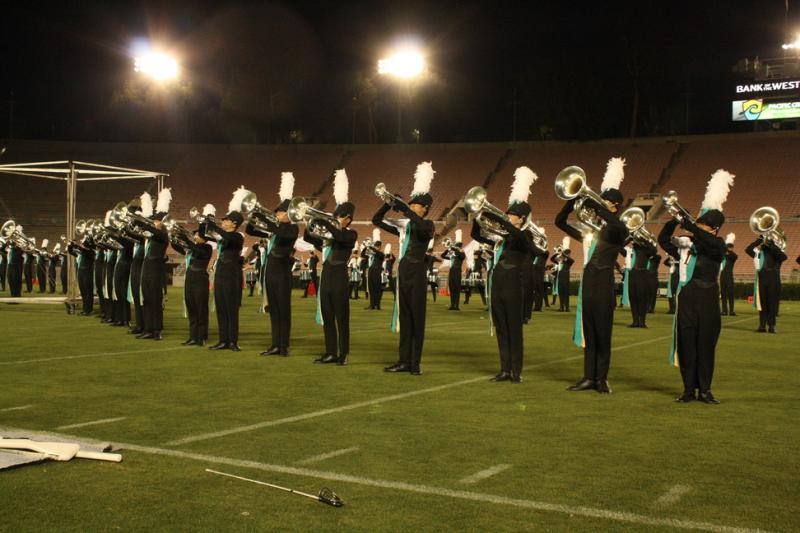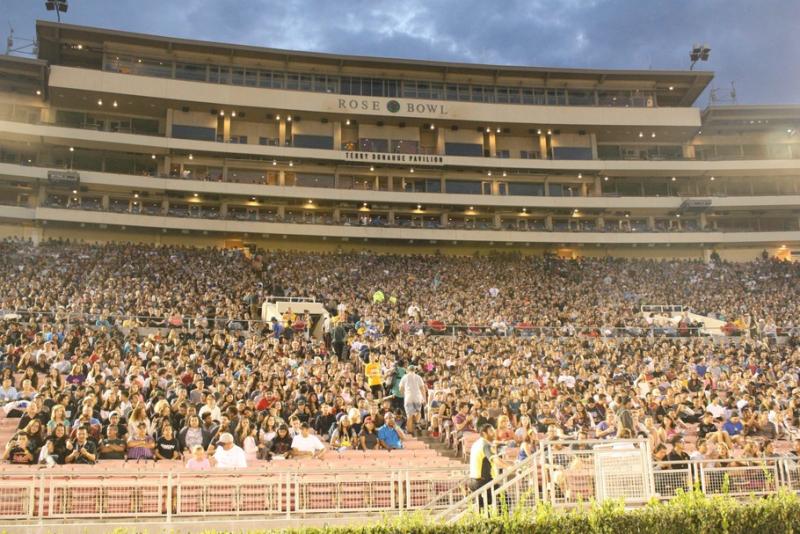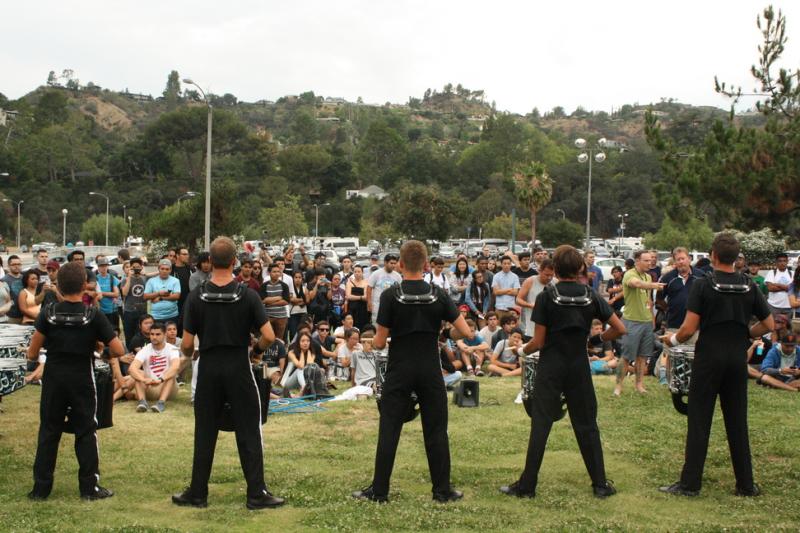Drum Corps Show Higher Level Of 'Band Geek'

As the first week of August marked the beginning of the end of summer, thousands of marching band geeks made a pilgrimage to Indianapolis, Indiana. The devout-from old band directors to parents carrying future musical prodigies-gathered in Lucas Oil Stadium to admire their heroes- uniformed performers wielding brass instruments, drums, and colorful flags. Thousands more gathered online to watch the livestream of the performances from home.
For the 43rd year, drum corps from around the nation competed in championships.
“Many people liken [drum corps] to marching band on steroids,” quips Jeff DeMello, who is on the board of directors for the drum corps Blue Devils.
The analogy isn’t so far fetched. A drum corps looks like a typical marching band, with a color guard, percussion and brass musicians. But unlike a typical marching band, there are no woodwind instruments (like flute or saxophone), trombones or french horns. Also unlike most marching bands, drum corps are not affiliated with a school or university. Members’ ages can range from high schoolers to 21-year-olds in world class drum corps.

As such, drum corps are nonprofit organizations that members pay to be a part of. The amount of money a member spends per season depends on the corps, but some members can spend up to thousands of dollars in fees. They pay the fees because they really want to march in a corps, notes Bill Watson, brass consultant for Blue Devils.
“Members want to be here, and they pay good money to be here, and so they are the most teachable students that I have ever seen,” says Watson.
The Marching Major Leagues
Like any sport, drum corps has a season. Potential performers audition at 22 world class and 27 open class corps across the nation in November. Once a corps’ members are selected, they meet up throughout the winter and early spring to learn the show’s music and marching techniques. The entire corps comes together in May to rehearse the show with music, choreography and marching.
Starting in June, corps compete at shows throughout the nation, eventually competing in championships in August, hosted by the governing body Drum Corps International (DCI). In order to put out award-winning shows, 12-hour rehearsals in heat and humidity are necessary. But the nature of their work—playing or dancing while also maintaining perfect formations—can be extremely exhaustive.
Don't believe it? Watch this clip from ESPN that compares drum corps performers to professional athletes:
Not a lot of people would want to march after rolling their ankles on uneven ground, getting shin splints or even pulling their groin like Gerardo Samaneigo, a current color guard member of Southern California’s world class corps, Pacific Crest. But members don’t want to fall behind in rehearsal because “then you’re holding the team back,” Samaneigo explains. For corps members, the price of a few scrapes is worth the thrill of performing for screaming crowds.
“It's what makes us feel like there's a reason for us to wake up and work hard every morning. We want to be what we believe are the best versions of ourselves and when I'm performing I feel like I've hit my maximum,” says Samaneigo.

In the months leading to DCI Championships, performers give their best at competitions large and small across the country, and are growing in audience attendance each year.
Pacific Crests’ “Corps at the Crest”competition, for instance, isn’t a big regional competition, but world class corps favorites like Blue Devils, Santa Clara Vanguard and Phantom Regiment travel miles (sometimes even from out of state) to perform, and having those names draws crowds. The high ticket demand for this year’s “Corps at the Crest” led Pacific Crest to move its competition from local community colleges to the Rose Bowl.
“We wanted to create something bigger and grander,” says Stuart Pompel, the executive director of Pacific Crest. Pommel estimated that about 6,000 people attended the event, with 2,000 people coming from local high school groups.
Arturo Alvarado, who plays in the drumline of Gladstone High School’s marching band in Covina, California, was one of those people.
“I’ve watched drum corps for four years,” says Alvarado, “I remember after my first drum corp show live I tried to perfect all the stuff at high school because they were so easy compared to the [formations] these drum corps would do.”
Community In The Lot
Because drum corps is considered the highest level of the marching arts, many people involved in the marching world-whether at the middle school, high school, or college level-attend shows. Fans are usually family and friends, music and color guard instructors, students like Alvarado, and alumni who aged out of corps after turning 21.
For Josh Serviens, who played snare drum in Phantom Regiment in 2013 and 2014, driving out to Pasadena from his home in Las Vegas was worth the trip.
“This is my first year not marching, so I had to see a show,” Serviens says, “and this is the closest one to me within driving distance that I can afford right now...there’s no way that I was going to miss a season.”
But people attend shows because they love the activity itself. Jay Looby of North Hollywood went to the Rose Bowl even though his home corps, the Cavaliers Drum & Bugle Corps, wasn’t performing, “I am a Cavalier, but I support the activity and that’s the big idea here, we want to come out and support the people doing it now.”

Fans can support their favorite drum corps by watching them “in the lot,” the parking lots or area around the stadium where performers warm up before they hit the field. For marching students, watching corps in the lot is equivalent to a Lakers fan getting to stand five feet away from Kobe Bryant as he practices his freethrows. Seeing the dedication and the discipline put into a show inspires students to audition someday. For Alvarado, the prospect of being in Santa Clara Vanguard’s drumline is an incentive to practice more.
“It just motivates me to go home and...make sure everything so perfect with the [metronome] so that one day I can make that line,” Alvarado says, “I know how hard it is to make it in.”
Performers like David Warren, the Phantom Regiment drum major (the lead corps member who conducts the corps), understand what it’s like for fans to watch their shows live because they were inspired by live shows themselves.
With that in mind, Warren says that corps always put in a big effort to put on a good show, “It’s not about competition, it’s about playing for your audience.”
Beyond supporting the activity and inspiring future performers, drum corps shows are ways for people to meet up and see each other when they usually can’t. Watson, who has been involved with drum corps shows for 20 years, loves to see alumni at shows, especially when the alumni bring their own students.
“I’ve walked through here and seen a lot of teachers that marched in this corps...And that’s a great feeling as a band director to see another one of my ex-students.”
READ MORE: CBS Sports Show Host Learns To Not Mess With Band 'Dorks'

Beyond Competition
Touring around the country with 200 or so people, however, isn’t an easy task, says Ricky Grassos, a Blue Knights alumnus who is now assistant tour director, “I definitely have a lot more respect for this side of drum corps.”
There are a lot of factors that go into a drum corps; in addition to finding places to sleep and rehearse while on tour, which can take up to 5-7 months in advance, drum corps also have to figure out a way to feed everyone on tour 3-4 times a day. Grassos says that corps also travel with multiple coach busses and semi-trailers that need to be filled and maintained everyday. In addition, all instruments, props and equipment need to be maintained. With such costs, Pompel estimates that Pacific Crest’s tour cost just under $1 million, and Blue Devils executive director David Gibbs estimates their tour to cost between $750,000 to $1 million.
But the cost of shows is nothing compared to the friendship and memories that performers create over a season. Dean Patterson, a former Phantom Regiment drum major, came back to help with their tour not necessarily because he misses performing.
“What I miss the most is the people...the atmosphere, the attitude, that’s an amazing group of people to be with, so that’s why I came back... for the family, the camaraderie that we create,” Patterson says.
Modern American drum corps has only been around for 43 years, but younger generations who are passionate about drum corps like Alvarado will inherit an already impressive legacy. Drum corps has its own governing body, Movie theaters stream competitions, DCI has its own hall of fame and some publications are dedicated entirely to drum corps. Drum corps may not be a mainstream activity like basketball or football, but it is similar to sports culture in that there is a strong sense of community, pride and tradition for those invested in the activity, whether they're on the field or in the stands.
After this week, months of planning, rehearsals, performances and memories will come to an end. The call to the field, however, will soon begin again with November auditions. For many of the marching devout, the call for music excellence, elite performance and lasting friendship will be too tempting to resist.
Reach Staff Reporter Heidi Carreon here and follow her on Twitter here.



